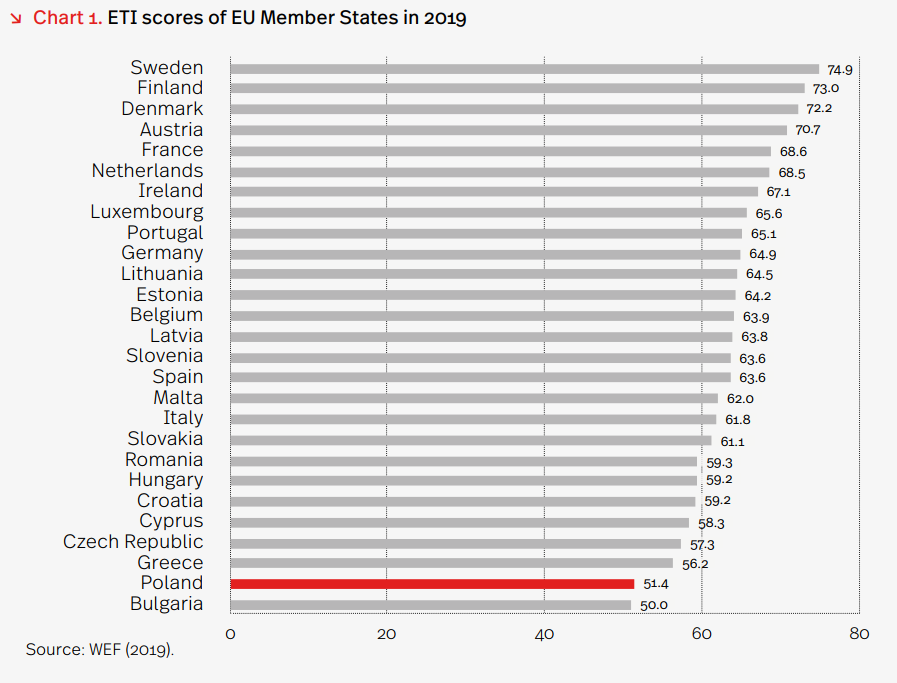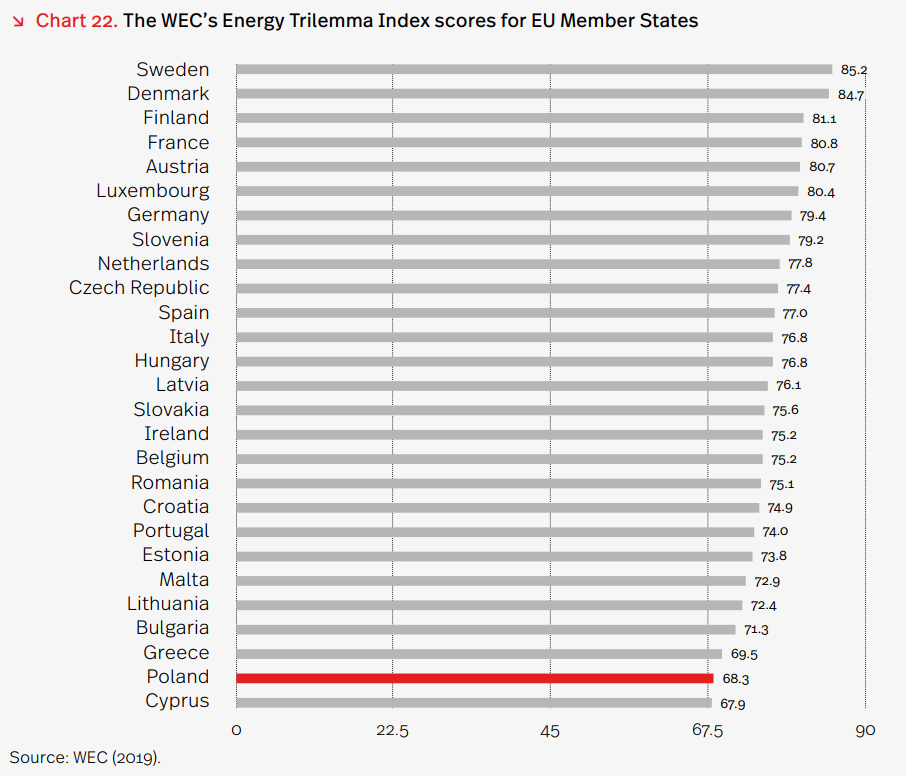According to the baseline version of calculations of the PEI, Poland can achieve climate neutrality by 2056. Sweden, Finland and Denmark lead the way in energy transition in the EU

Published: 19/08/2020
Out of the 115 countries covered by the Energy Transition Index (ETI) 2019 prepared by the World Economic Forum (WEF), the EU Member State most advanced in energy transition towards a zero-carbon economy was Sweden, the leader in the ranking, whereas the poorest performer, ranked 77th, was Bulgaria.
Poland was not far ahead, ranking as low as 75th. Despite significantly differentiated conditions, only three EU Member States have declared achieving early the objective of climate neutrality by 2050 adopted by the Council of the EU in December 2019: Finland by 2035, Austria by 2040 and Sweden by 2045. As the only Member State, Poland has provided no planned date of achieving decarbonisation. According to calculations based on the Energy Transition Index values and the assumed years of decarbonisation in the other EU Member States, an optimistic version suggests that Poland could become climate-neutral by 2056, but it might be as late as 2067 in a negative scenario – as follows from the report of the Polish Economic Institute entitled ‘Time for decarbonisation’.
Considering socio-economic development indicators, countries such as Bulgaria, the Czech Republic and Poland will face a difficult task of achieving the climate neutrality goal. In terms of the Energy Transition Index (ETI) scores, they ranked 77th, 75th and 49th respectively, which means that the energy sectors in the countries in question are much less modernised than, for example, in the Scandinavian countries. It is mostly due to a high share of fossil fuels in the energy mixes of those countries, electricity systems characterised by low flexibility and unstable business development conditions in that area. The top 6 EU Member States in the ETI ranking were Sweden, Finland, Denmark, Austria, France and the Netherlands.
On the basis of the ETI data and the decarbonisation years declared by the EU Member States, analysts of the Polish Economic Institute calculated that the Polish energy sector should achieve climate neutrality by 2056. At the same time, only relying on the ETI scores of the Member States having published comprehensive strategies for becoming climate neutral, Poland was estimated to be able to attain that objective as late as 2067.
In the ETI ranking, Poland obtained high scores for energy efficiency investment (among 26 countries with 0.29 per cent), investment freedom (23rd place) and good logistics performance (26th place). Poland ranked the lowest in categories such as the share of electricity from coal (112th place), electricity system flexibility (110th), policy stability (102nd) and the carbon intensity of primary energy supply (108th).
The ranking prepared by the World Energy Council identified the same leaders as the ETI
Interestingly, the energy transition readiness scores of the ETI ranking leaders were confirmed by the Energy Trilemma Index prepared by the World Energy Council (WEC) and based on three core dimensions: Energy Security, Energy Equity and Environmental Sustainability of Energy Systems. In terms of the above factors, 8 out of the 10 leaders ranked in the top ten ETI performers as well.
The difference between the ranking prepared by the World Energy Council and the ETI is that the former allows to capture the dynamics of change observed in particular countries from 2000. Therefore, it is possible to note that Poland had made the most significant progress in the category of Environmental Sustainability of Energy Systems.
Poland’s low rank was determined, among other things, by the still vast share of coal in electricity supply in Poland. In 2018, coal-fired power plants produced 79 per cent of electricity. Other major electricity supply sources included wind energy (8 per cent), gas (7 per cent) and biofuels (4 per cent). Due to the dominant share of electricity from coal in Poland, our energy sector is characterised by the second highest carbon intensity in the European Union (773 g of CO2/kWh and 11 tonnes of CO2/person against the EU average of less than 300 g of CO2/kWh and 9.4 tonnes of CO2/person in 2017). A higher level of carbon intensity was only noted by Estonia.
The Scandinavians at the forefront of energy transition
In Sweden, nuclear energy and hydropower account for 80 per cent of total electricity production. Due to such a structure of energy supply, Sweden ranked among the EU Member States characterised by the lowest carbon intensity (ca. 13 g of CO2/kWh and 5.5 g of CO2/person).
Finland also significantly relies on nuclear energy (33 per cent in 2018) and hydropower (19 per cent). Biofuels and coal contribute to a lesser degree (17 per cent and 14 per cent respectively). In Denmark, the most important role in electricity production is played by wind farms (46 per cent), still significantly complemented by coal-fired power plants (21 per cent) and – as in the case of Sweden and Finland – biofuels (17 per cent). However, primary energy supply still largely relies on crude oil (38 per cent) and gas (16 per cent). Denmark made significant progress with regard to the carbon intensity of its energy sector – whereas in 2007 the carbon intensity slightly exceeded 400 g of CO2/kWh, in 2016 it dropped to 166 g of CO2/kWh. It allowed Denmark to reduce its carbon intensity to nearly half of the EU-28 average.
With regard to the ETI score, Austria ranked immediately behind the top three in the European Union and 6th worldwide. Its high rank was due to a significant share of hydropower (60 per cent). Other major sources are gas (14 per cent) and wind energy (9 per cent). Austria is distinguished by a lower carbon intensity in comparison with Denmark or Finland (85.1 g of CO2/kWh in 2016).
‘In the case of both the European Union Member States and non-EU countries, the energy transition leaders having departed from coal – despite considerable contributions from sources such as photovoltaic and wind energy – have stable energy supply independent of weather conditions. Electricity is usually generated by hydroelectric and nuclear power plants. Some countries have gas-fired power plants, characterised by half of the carbon intensity of coal-fired facilities. Due to the natural conditions in Poland, the optimal medium-term choice would be to rely on the last two of the above-mentioned alternatives. In a longer perspective, a desirable scenario would be to gradually replace fossil fuels with offshore wind farms and low-carbon hydrogen,’ notes Aleksander Szpor, the head of the climate and energy team of the Polish Economic Institute.
Polski Instytut Ekonomiczny to publiczny think tank gospodarczy, którego historia sięga 1928 roku. Obszary badawcze Polskiego Instytutu Ekonomicznego to przede wszystkim handel zagraniczny, makroekonomia, energetyka i gospodarka cyfrowa oraz analizy strategiczne dotyczące kluczowych obszarów życia społecznego i publicznego Polski. Instytut zajmuje się dostarczaniem analiz i ekspertyz do realizacji Strategii na Rzecz Odpowiedzialnego Rozwoju, a także popularyzacją polskich badań naukowych z zakresu nauk ekonomicznych i społecznych w kraju oraz za granicą.
Kontakt dla mediów:
Agata Kołodziej
Kierownik Zespołu Komunikacji
tel. 48 727 427 918
Kategoria: Climate and Energy / Press releases / Report / Reports 2020







